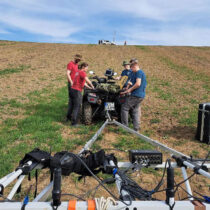The creation of the katholikon of the Xeropotamou monastery (1764), from the original planning of the project and the raising of the necessary funds to the completion of its erection, is examined in this article. Source of the relevant research, besides the building itself, was the model of the original architectural scheme, which was found in the monastery, and also a host of information, located in the various texts of Kairsarios Daponte (1713-1781), especially in his unpublished accounts concerning the building. He was not only a monk, but also a well-known scholar and the pioneer of the entire reconstruction project. Kaisarios undertook an eight-year tour in the bordering the Danube principalities, Constantinople and the Aegean islands in order to raise funds for the aforementioned project. During his sojourn in Constantinople, he commissioned the royal architect Constantine to form an architectural proposal, which was expressed in the wooden model on scale, while at the same time he obtained all the necessary building material that he forwarded to the worksite. The iconographic program of the katholikon, which was executed by the well-known-group of the Epirotan painters Athanasios, Konstantinos and Naum, was also created by Kaisarios. The katholikon of the Xeropotamou monastery is significant for the study of the Post-Byzantine architecture, because it offers us the opportunity to trace many, unknown until now, aspects of the procedure of realizing an architectural project in Greece during the years of the Ottoman rule. It is thus possible to investigate the chapter of the architectural design and to identify eponymous creators; to scrutinize the interrelations between Moslem and Greek Orthodox church-building and to clarify many data regarding construction, materials and architectural members; and finally, to collect important information on the cost of materials and services and to reveal interesting details about the assignment of wall-painting entities to groups of religious painters.
The Katholikon of the Xeropotamou Monastery
23 Aug 2012
by Archaeology Newsroom
- A
- A
- A

